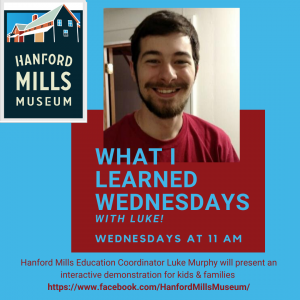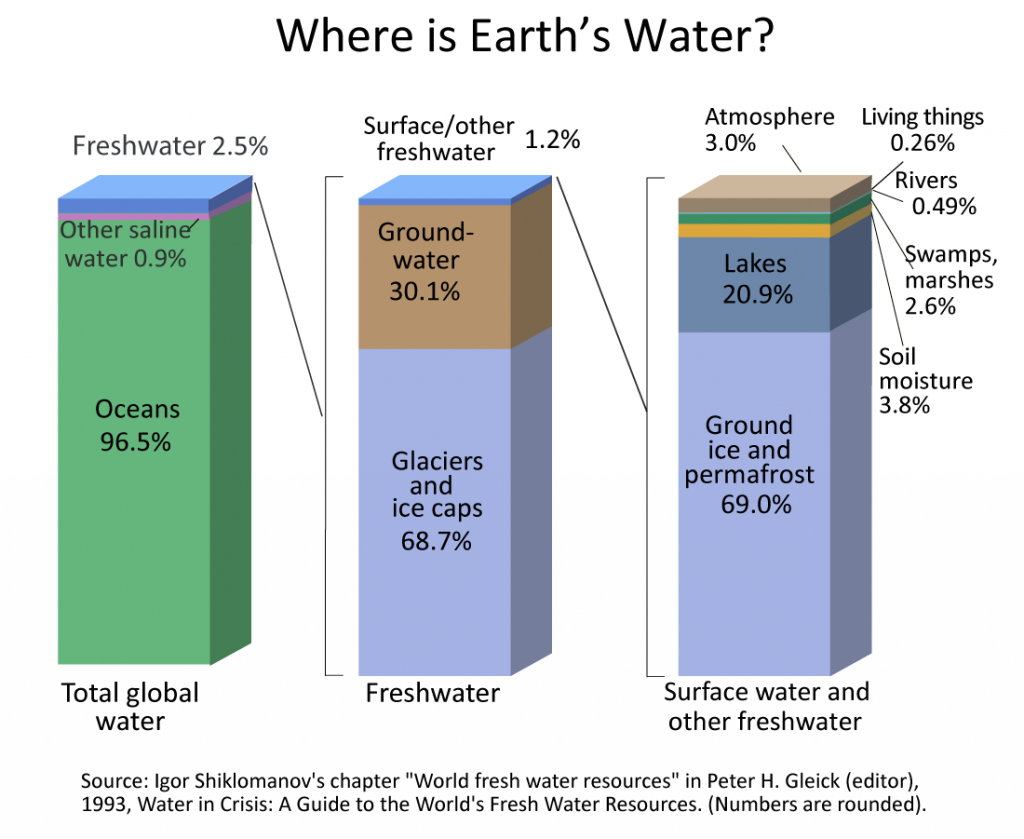What I Learned Wednesdays feature Hanford Mills Museum Education Coordinator Luke Murphy presenting an interactive exploration. Join us Wednesdays at 11 am for a Facebook Live event on the Hanford Mills Museum Facebook Page. Ask questions, offer suggestions, and share your ideas. The videos are also posted on this page.
Have a topic you’d like Luke to talk about? Let us know. We look forward to connecting with you online, and bringing you the resources of Hanford Mills Museum. #MuseumatHome
July 16: Waterwheels
Luke starts off in the basement of the mill, and tells us about the 1926 Fitz Overshot Waterwheel. Learn how waterwheels work, and see the 12 foot wide, 10 foot high waterwheel turn and provide power for the mill. Then, Luke shows us how to make a mini-waterwheel with 2 paper plates, paper cups, tape, glue, and a pencil (or dowel).
July 8: How do Ice Houses Work?
Though Hanford Mills Museum is not yet open to the public, Luke is able to be on site and show us the ice house. Find out how this simple wooden structure can keep ice frozen for months. Luke also shows us how to make a model ice house out of cardboard. Experiment and see how it keeps ice from melting.
July 1: Steam Power
Hanford Mills Museum is a great place to learn about STEAM (Science, Technology, Engineering, the Arts, and Math) but also a great place to learn about steam power. After using waterwheels for decades, the mill’s owners in 1895 brought in steam boiler and steam engines. Luke tells us about steam power at Hanford Mills, and then shows us how to make a model steam boiler out of cardboard. Watch on Facebook or click on the video below the historic photograph.
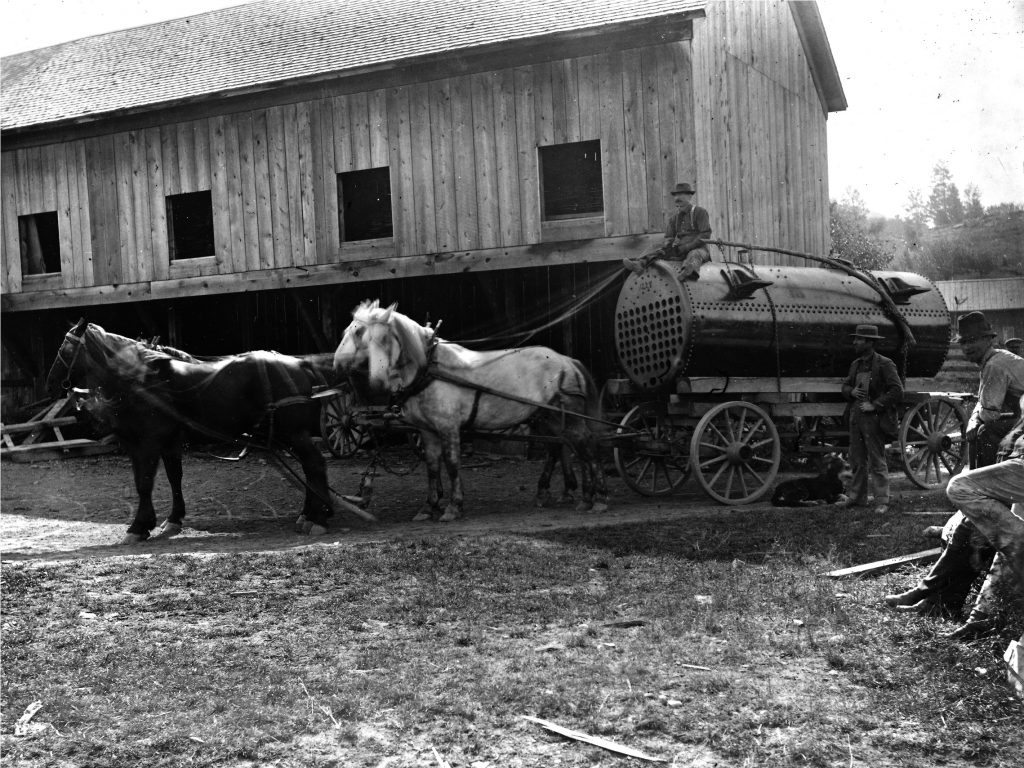
May 27: What is a Museum?
Luke tells us about museums and many of the things they do, especially Hanford Mills Museum. And, he shows us how to make a mini-magazine to showcase what you would like to feature in your personal museum. (You will need an 8 1/2 x 11 inch piece of paper and scissors)
May 20: Simple Machines
Luke tells us about the six simple machines, and shows us how to make a mini-catapult. (You will need 7 craft sticks, 7 rubber bands, 1 plastic spoon, 3 cotton balls)
May 13: Dendrochronology
How is that for a big word? Luke tells us about trees and “dendrochronology”, or tree-ring dating. “For the entire period of a tree’s life, a year-by-year record or ring pattern is formed that in some way reflects the climatic and environmental conditions in which the tree grew.” (source Cornell Tree-Ring Laboratory). See what tree rings can tell us about tree growth, and make a tree-ring illustration of your life. (Luke shows us how). We can also this site for seeing which trees grow in each state.
May 6: Trains!
Starting with their introduction in the 1800s, trains helped to connect people faster and further than ever before. Learn about trains in the Catskills, how they helped Hanford Mills, and how to make your own train whistle! Luke talks about how long it took to cross the country by train and how the speed of trains changed travel (here’s some more information and maps). He also talks about the Oneonta Roundhouse, which was the largest in the world, and how the image on Utah’s quarter features the locomotive Jupiter, which was built in Schenectady, NY.
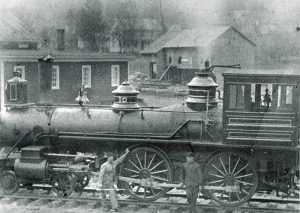
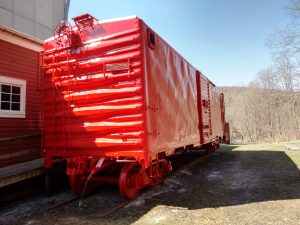
April 29: Make-your-own Fossils
Did you know that fossils from the world’s oldest forests are located not far from Hanford Mills Museum, in Gilboa and Cairo, New York? Luke tells us about these ancient forests, then shows us how to make “fossils” using flour, salt, coffee grinds and coffee. He also mentions the official fossil of New York State, the sea scorpion or Eurypterus Remipes.
April 22: Pollution
It’s Earth Day, so Luke is talking about the importance of keeping the air, land and water clean. He has an activity that replicates water pollution, and the ways water can be cleaned up. Watch the video, then follow these instructions so you can do the “Trying to Clean Up” activity at home.
April 15: Renewable Power
Find out about renewable power, and how it was used at Hanford Mills. Luke also shows us how to make a solar oven using things you may have at home, like a pizza box, aluminum foil, and plastic wrap. The homemade solar oven can warm up a snack, like s’mores, or melt the cheese on your nachos.
April 8: Forests and Water Health
We love to walk in the woods. Trees are amazing things. In addition to their beauty, they provide wildlife habitat, transform carbon dioxide into oxygen we can breathe, and are a natural resource, so we can have lumber, like we cut at Hanford Mills Museum. In this week’s “What I Learned Wednesday,” Luke tells us about another key role trees and forests play: keeping water clean. See how he uses chocolate syrup, ripped-up paper towels, and crushed cereal to show us how trees clean water!
Luke also made an Activity Guide on Forests and Water Health that you can view online or print out at home. The Guide includes a supply list and directions for how to do an experiment at home.
<
April 1: Dairy
Find out what Hanford Mills made for Delaware County dairy farmers in the 19th century, learn some fun facts, and see how you can make butter at home. Dairy farms near Hanford Mills Museum include Clark Farms, a fifth-generation family farm, and Byebrook Farm, an eighth-generation family farm (you may know them from the delicious Gouda Cheese they sell at Hanford Mills events). Both operate stores on the farm where you can buy milk. For these and other Catskill farms, restaurants, and general stores that are open during the COVID 19 crisis, please see SisBoomYum.com, a collaboration of the MARK Project, Delaware County Chamber of Commerce, and Great Western Catskills.
Make Butter at Home
Want to make butter like Luke does in the video? You’ll need a couple tablespoons of heavy cream and a jar with a tight fitting lid. Luke uses baby food jars. Put the cream in the jar, make sure the lid is on tight, then shake. After a few minutes, the cream will solidify into butter. Try it out on a cracker.
March 25: Water and Water Power
Almost 75 percent of the world is covered in water, but there’s only a small amount that we can drink. We have to protect the water we have. Water is not only important for drinking, but also for energy. Long before we had electricity or gasoline engines, water powered the machines at Hanford Mills, and still does 174 years later!
Watch this video to see the 10-foot high and 12-foot wide Fitz overshot waterwheel in action.


